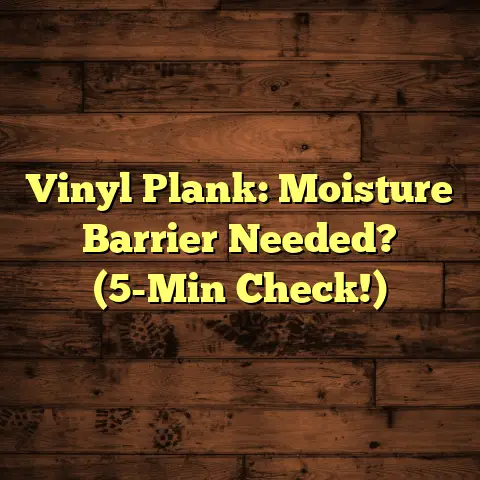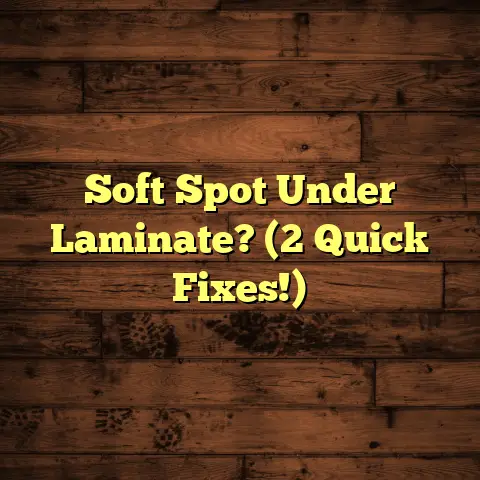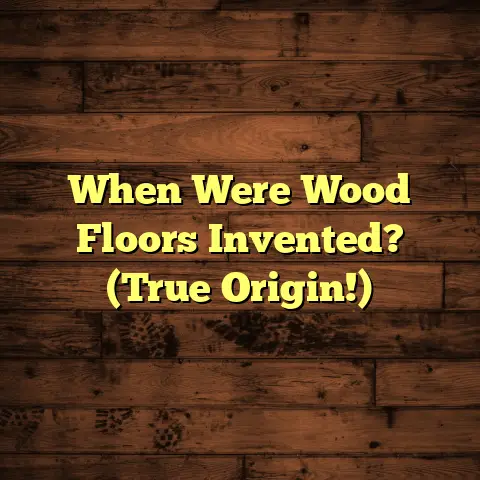Garage Floor Paint Costs? (5 Quote Red Flags!)
I’m a flooring contractor, and I’ve seen it all when it comes to garage floors.
From oil stains that look like abstract art to cracks that could swallow a golf ball, I’ve tackled it all.
And lately, I’ve noticed more and more folks are wanting to spruce up their garages.
Not just with any old paint, but with stuff that’s good for the planet too.
That’s right, eco-friendly garage floor paint is trending!
We’re talking low-VOC options, water-based paints, and even some made from recycled materials.
But before you jump in and give your garage a green makeover, let’s talk money.
And more importantly, how to avoid getting ripped off.
Because trust me, I’ve seen some shady quotes in my day.
So, grab a cup of coffee, and let’s dive into the world of garage floor paint costs.
I’ll show you what to look for and, most importantly, what to avoid.
Understanding Garage Floor Painting Costs
Alright, let’s break down what goes into the price of painting your garage floor.
It’s not just about slapping on a coat of paint, believe me.
Several factors play a role, and understanding them is key to getting a fair price.
-
Garage Size: This one’s obvious, right? The bigger the floor, the more paint and labor needed.
-
Floor Material: Concrete is the most common, but is it smooth? Porous? Previously coated? All affect prep work.
-
Paint Quality: This is HUGE. Cheap paint might save you upfront, but it’ll chip, peel, and stain faster.
You’ll be redoing it sooner than you think.
-
Prep Work: This is where contractors can cut corners. Proper cleaning, patching, and etching are vital for adhesion.
-
Labor Costs: This varies based on experience, location, and the complexity of the job.
Now, let’s talk average prices. Keep in mind these are just estimates, and your actual cost could vary.
| Paint Type | Material Cost (per sq ft) | Labor Cost (per sq ft) | Total Cost (per sq ft) |
|---|---|---|---|
| Epoxy | \$3 – \$7 | \$2 – \$5 | \$5 – \$12 |
| Polyurethane | \$4 – \$8 | \$3 – \$6 | \$7 – \$14 |
| Acrylic | \$2 – \$5 | \$1 – \$3 | \$3 – \$8 |
Data is from 2023-2024 estimates from various contractor publications.
Epoxy is a popular choice, known for its durability and resistance to chemicals.
Polyurethane offers excellent abrasion resistance and a glossy finish.
Acrylic is a more budget-friendly option, but it’s not as durable as epoxy or polyurethane.
Don’t forget to factor in regional differences.
Labor costs in New York City will be way higher than in rural Kansas.
Also, material prices can fluctuate due to supply chain issues or seasonal demand.
For example, during the summer months, when everyone’s doing home improvement projects,
you might see a slight increase in paint prices.
The Importance of Getting Quotes
Okay, you know the factors that affect the price. Now, how do you get an actual number?
Simple: get multiple quotes.
I can’t stress this enough. Getting just one quote is like buying a car without test driving it.
You’re going in blind!
Here’s why getting multiple quotes is crucial:
-
Market Rate: It gives you a sense of the average cost in your area.
-
Quality of Service: The quote itself can tell you a lot about the contractor’s professionalism.
Is it detailed? Clear? Does it address your concerns?
-
Trustworthy Contractors: Comparing quotes helps you weed out the guys who are trying to rip you off.
-
Negotiating Power: Having multiple quotes gives you leverage to negotiate a better price.
I always recommend getting at least three quotes.
That gives you a good range to compare and contrast.
When you contact contractors, be clear about what you want.
Tell them the size of your garage, the current condition of the floor, and the type of paint you’re interested in.
The more information you provide, the more accurate their quotes will be.
Identifying Red Flags in Quotes
Alright, here’s the meat of the matter. You’ve got your quotes in hand. Now what?
Time to play detective and look for those red flags that scream, “Danger! Proceed with caution!”
Here are five red flags I’ve seen time and time again:
1. Unusually Low Estimates
This is the biggest red flag of them all.
If a quote is significantly lower than the others, there’s usually a reason.
Maybe they’re using cheap materials, cutting corners on prep work, or they’re simply inexperienced.
I remember one homeowner who went with the lowest bidder.
The contractor used a watered-down epoxy that started peeling within months.
He ended up paying more in the long run to have it redone properly.
Don’t be tempted by a low price. It’s often too good to be true.
2. Vague Descriptions of Services
A good quote should be detailed and specific.
It should list the type of paint they’re using, the number of coats, and the steps involved in the preparation process.
If the quote just says “paint garage floor” with a price, that’s a huge red flag.
You need to know exactly what you’re paying for.
Vague descriptions often lead to unexpected costs down the road.
The contractor might say, “Oh, that extra prep work wasn’t included in the original quote.”
3. Lack of Licensing and Insurance Information
This is non-negotiable. Any contractor you hire should be licensed and insured.
Licensing ensures they meet certain standards of competence and professionalism.
Insurance protects you in case of accidents or damage to your property.
Hiring an unlicensed contractor is a huge risk.
If they mess up the job or someone gets hurt on your property, you could be held liable.
Always ask for proof of licensing and insurance before hiring anyone.
You can also check with your local licensing board to verify their credentials.
4. Pressure Tactics
A trustworthy contractor will give you time to consider their quote.
They won’t pressure you into signing a contract on the spot.
If a contractor is using high-pressure sales tactics, that’s a sign they might be untrustworthy.
They might say things like, “This price is only good today!” or “We have another job lined up, so you need to decide now!”
Don’t fall for it. Take your time, do your research, and make an informed decision.
5. No References or Reviews
In today’s digital age, there’s no excuse for a contractor not to have references or online reviews.
A reputable contractor will be happy to provide you with a list of past clients you can contact.
They’ll also have plenty of positive reviews on websites like Yelp, Google, or Angie’s List.
If a contractor can’t provide references or has mostly negative reviews, that’s a major red flag.
Take the time to check their online reputation before hiring them.
Additional Considerations for Eco-Conscious Homeowners
Okay, so you want a great-looking garage floor, but you also want to be kind to the planet.
I get it! Here’s how to balance cost with eco-friendly choices:
-
Low-VOC Paints: VOCs (volatile organic compounds) are harmful chemicals that can pollute the air.
Look for paints labeled “low-VOC” or “zero-VOC.”
These paints are better for your health and the environment.
-
Water-Based Paints: Water-based paints are generally more eco-friendly than solvent-based paints.
They’re easier to clean up and release fewer harmful fumes.
-
Recycled Content: Some paints are made with recycled materials, which reduces waste and conserves resources.
-
Contractor’s Values: Choose a contractor who shares your eco-friendly values.
Ask them about their sustainability practices and the products they use.
I make sure to properly dispose of waste materials and use energy-efficient equipment whenever possible.
Cost vs. Sustainability: Eco-friendly paints can sometimes be a bit more expensive than conventional paints.
But the benefits to your health and the environment are worth the investment.
Plus, they often last longer, which can save you money in the long run.
Conclusion
Choosing the right contractor and paint for your garage floor can be a daunting task.
But by being vigilant and looking out for those red flags, you can avoid getting ripped off.
Remember to get multiple quotes, read the fine print, and check references.
And don’t be afraid to ask questions!
A good contractor will be happy to answer your questions and address your concerns.
By investing in quality work and eco-friendly options, you can create a garage floor that looks great,
lasts for years, and is good for the planet.
Happy painting!





